Research on the Pressure Distribution Law of Synchronous Grouting in Shield Tunnels and the Force on Segments
Abstract
:1. Introduction
2. The Mathematical Model of Synchronous Grouting in Shield Tunnels
2.1. Synchronous Grouting
2.2. Assumption
- (1)
- The slurry is a non-compressed Bingham fluid and a monocomponent cement slurry;
- (2)
- The slurry exists only inside the gap channel, and its quality is not lost with the flow;
- (3)
- The boundary of the gap channel (the external border is the ground, and the inner boundary is the tunnel segment) does not experience slipping, and the slurry flow is laminar;
- (4)
- Only the radial speed of the slurry along the tunnel is considered, and the loss of speed of the slurry is not included.
2.3. Synchronous Grouting Pressure Distribution Equation
2.4. The Synchronous Grouting Pressure Distribution Calculation Model
2.5. The Stress of Shield Tunnel Segments in the Gap Channel at the Tail of the Shield
3. Engineering Case Study
3.1. Example Verification
- (1)
- In Figure 5, it can be observed that the theoretical calculation of the slurry pressure is basically consistent with the measured growth trend of the slurry pressure, and the slurry pressure shows a nonlinear increasing distribution from the arch top to the arch bottom. This is because when the slurry is filled in an upward direction, gravity performs negative work, while when it is filled in a downward direction, gravity performs positive work.
- (2)
- Through the comparison in Table 2, it was found that the theoretical and measured values of the slurry pressure at the tunnel arch crown, arch bottom, and two arch waists were 98.6%, 94.5%, 92.7%, and 101.1%, respectively. The error between the theoretical calculation results and the measured pressure on site did not exceed 10%, and the error was still within the allowable range of the project. Therefore, the theoretical model of synchronous grouting in shield tunnels in this study can effectively guide the design and construction of on-site shield tunnel grouting.
3.2. Analysis of Influencing Factors
3.2.1. The Shield Excavation Speed
3.2.2. The Thickness of the Shield Tail Gap
3.2.3. The Radius of the Shield Tunnel
4. Conclusions
5. Shortcomings and Prospects
Author Contributions
Funding
Data Availability Statement
Conflicts of Interest
References
- Liu, X.; Shen, S.; Xu, Y.; Zhou, A. Non-linear spring model for backfill grout-consolidation behind shield tunnel lining. Comput. Geotech. 2021, 136, 104235. [Google Scholar] [CrossRef]
- Ye, F.; Wang, B.; Han, X.; Liang, X.; Ying, K.; Liang, X. Review of shield tunnel backfill grouting tests and its diffusion mechanism. China J. Highw. Transp. 2020, 33, 92–104. [Google Scholar]
- Zhu, H.; Ding, W.; Qiao, Y.; Xie, D. Micro-disturbed construction control technology system for shield driven tunnels and its application. Chin. J. Geotech. Eng. 2014, 36, 1983–1993. [Google Scholar]
- Ye, F.; Xia, T.; Ying, K.; Li, Y.; Liang, X.; Han, X. Optimization method for backfill grouting of shield tunnel based on stratum suitability characteristics. Chin. J. Geotech. Eng. 2022, 44, 2225–2233. [Google Scholar]
- Liang, Y.; Yang, J.; Wang, S.; Zeng, X. A study on grout consolidation and dissipation mechanism during shield backfilled grouting with considering time effect. Rock Soil Mech. 2015, 36, 3373–3380. [Google Scholar]
- Ye, F.; Yang, T.; Mao, J.; Qin, X.; Zhao, R. Half-spherical surface diffusion model of shield tunnel back-fill grouting based on infiltration effect. Tunn. Undergr. Space Technol. 2019, 83, 274–281. [Google Scholar] [CrossRef]
- Tang, M.; Chen, R.; Chen, W. Stress monitoring and internal force analysis of Guangzhou metro shield tunnel segment during construction. China Civ. Eng. J. 2009, 42, 118–124. [Google Scholar]
- Liang, Y.; Zhang, J.; Lai, Z.; Huang, Q.; Huang, L. Temporal and spatial distribution of the grout pressure and its effects on lining segments during synchronous grouting in shield tunnelling. Eur. J. Environ. Civ. Eng. 2020, 24, 79–96. [Google Scholar] [CrossRef]
- Ye, F.; Mao, J.; Ji, M.; Sun, C.; Chen, Z. Research status and development trend of back-filled grouting of shield tunnels. Tunn. Constr. 2015, 35, 739–752. [Google Scholar]
- Ma, J.; Sun, A.; Jiang, A.; Guo, N.; Liu, X.; Song, J.; Liu, T. Pressure Model Study on Synchronous Grouting in Shield Tunnels Considering the Temporal Variation in Grout Viscosity. Appl. Sci. 2023, 13, 10437. [Google Scholar] [CrossRef]
- Wen, D.; Chao, D.; Yao, Z. The behavior of synchronous grouting in a quasi-rectangular shield tunnel based on a large visualized model test. Tunn. Undergr. Space Technol. 2019, 83, 409–424. [Google Scholar]
- Qiu, M.; Jiang, A. Backfill grout pressure distribution model for a metro shield tunnel. Mod. Tunn. Technol. 2013, 50, 115–121. [Google Scholar]
- Koyama, Y. Present status and technology of shield tunneling method in Japan. Tunn. Undergr. Space Technol. Inc. Trenchless Technol. Res. 2003, 18, 145–159. [Google Scholar] [CrossRef]
- Bezuijen, A.; Talmon, A.; Kaalberg, F.; Plugge, R. Field measurements of grout pressures during tunnelling of the Sophia Rail Tunnel. Soils Found. 2004, 44, 39–48. [Google Scholar] [CrossRef]
- Kasper, T.; Meschke, G. On the influence of face pressure, grouting pressure and TBM design in soft ground tunneling. Tunn. Undergr. Space Technol. 2006, 21, 160–171. [Google Scholar] [CrossRef]
- Koyama, Y.; Sato, Y.; Okano, N. Back-fill Grouting Model Test for Shield Tunnel. Q. Rep. RTRI 1998, 39, 35–39. [Google Scholar]
- Zhang, S.; Dai, Z.; Bai, Y. Model Test Research on distribution law of grout pressure for simultaneous backfill grouting during shield tunneling. China Railw. Sci. 2015, 36, 43–53. [Google Scholar]
- Liang, Y.; Huang, L. Grout pressure distribution characteristic in space-time domain of shield tunnels during synchronous grouting. J. Harbin Inst. Technol. 2018, 50, 165–170. [Google Scholar]
- Qiu, M.; Yang, G.; Jiang, A. Influence factors and pressure distribution of simultaneous grouting for shield tunnel. J. Shenzhen Univ. (Sci. Eng.) 2015, 32, 162–171. [Google Scholar] [CrossRef]
- Li, P.; Shi, L.; Li, X.; Liu, J. Theoretical model of longitudinal circumferential diffusion of synchronous grouting in shield tunnels. J. Tongji Univ. (Nat. Sci. Ed.) 2020, 48, 629–637. [Google Scholar]
- Ye, F.; Li, S.; Xia, T.; Su, N.; Han, X.; Zhang, C. Study on the grouting compaction splitting diffusion model behind the wall of shield tunnels in low permeability strata. J. Geotech. Eng. 2023, 45, 2014–2022. [Google Scholar]
- Cheng, H.; Liu, X.; Lin, J.; Zhang, L.; Li, M.; Rong, C. Study on fracturing and diffusion mechanism of non-slab fracturing grouting. Geofluids 2020, 2020, 1–9. [Google Scholar]
- Liu, X.; Cheng, H.; Li, M.; Wang, X.; Zhang, L.; Zhou, R. Theoretical research on longitudinal fracture grouting of deep buried strata based on slurry rheology. Rock Soil Mech. 2021, 42, 1373–1380+1394. [Google Scholar]
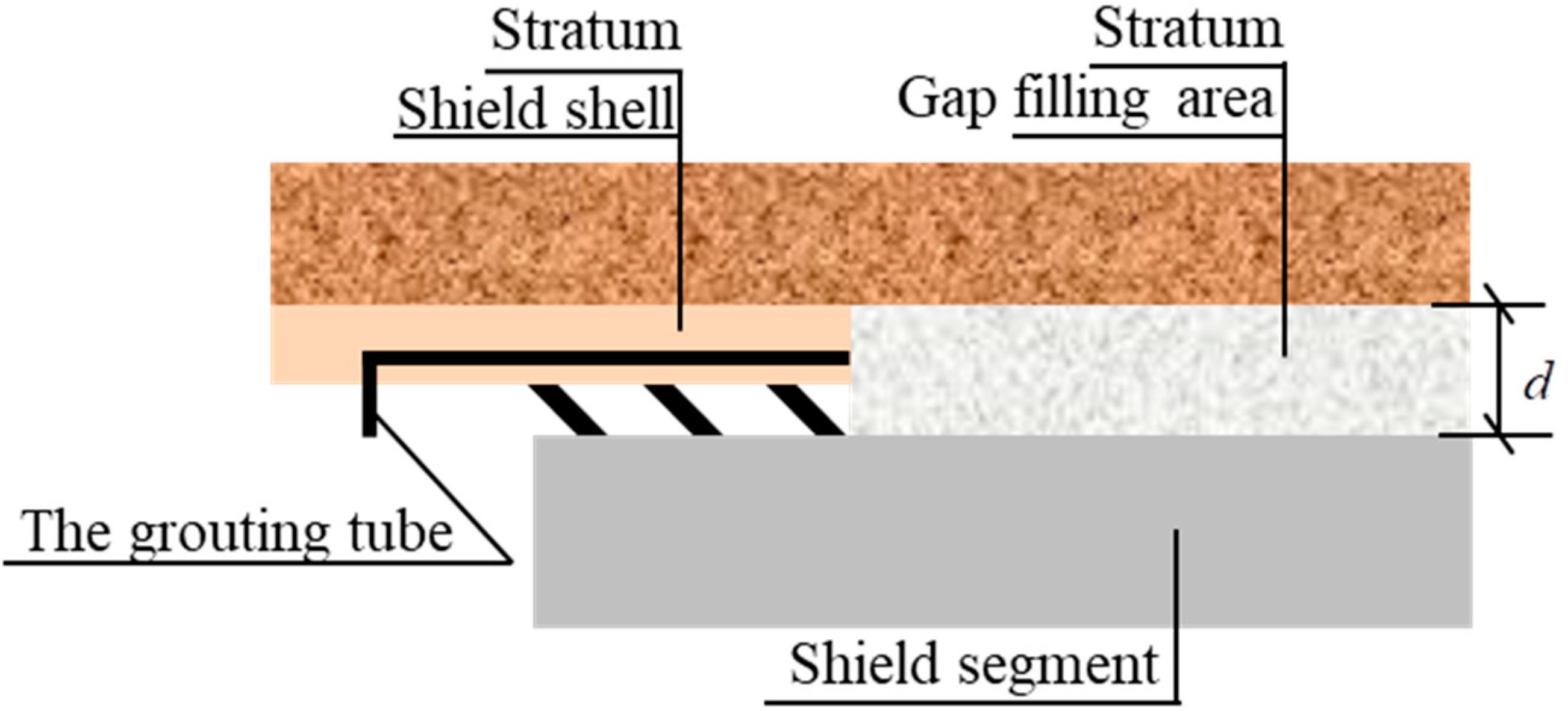

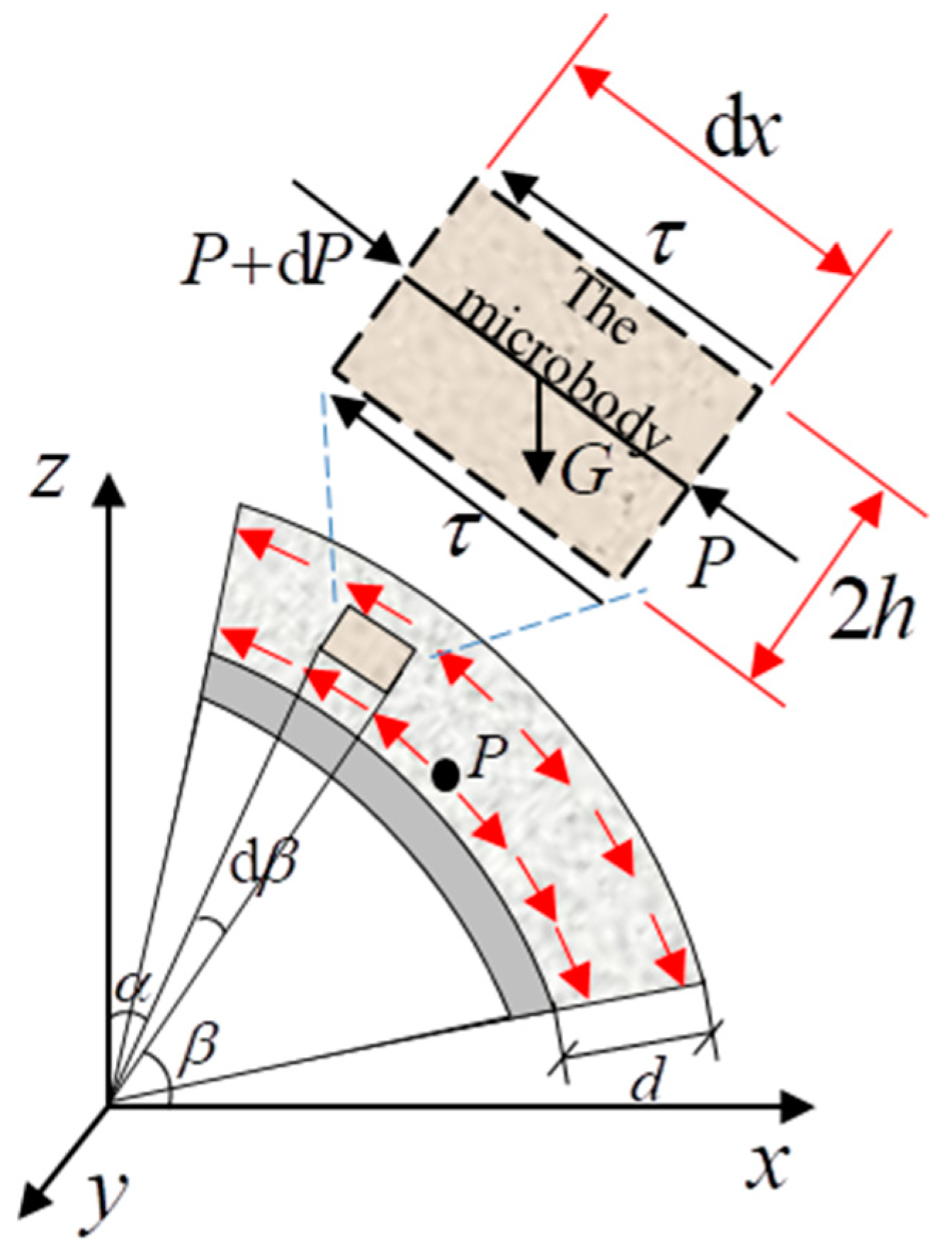
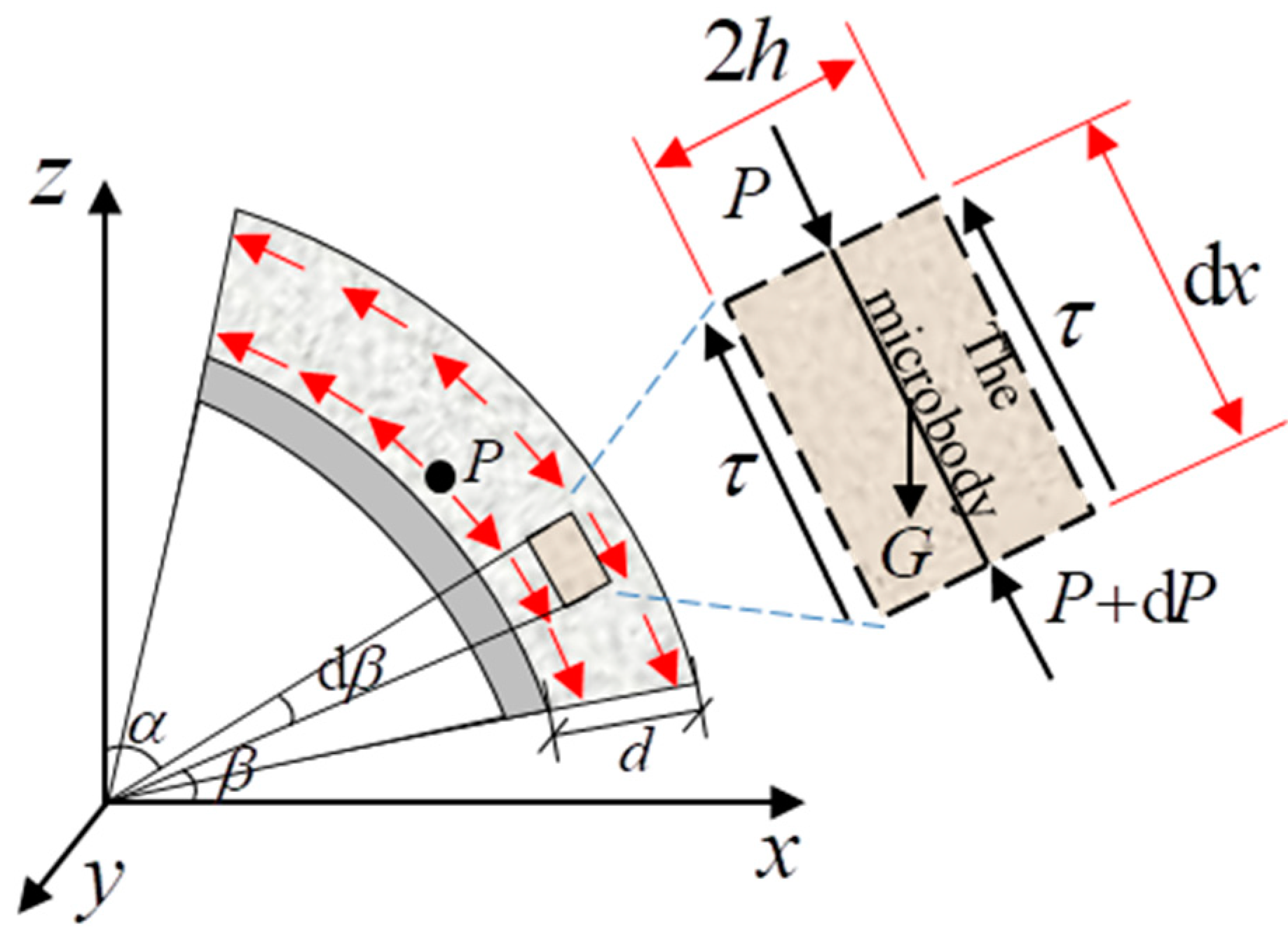


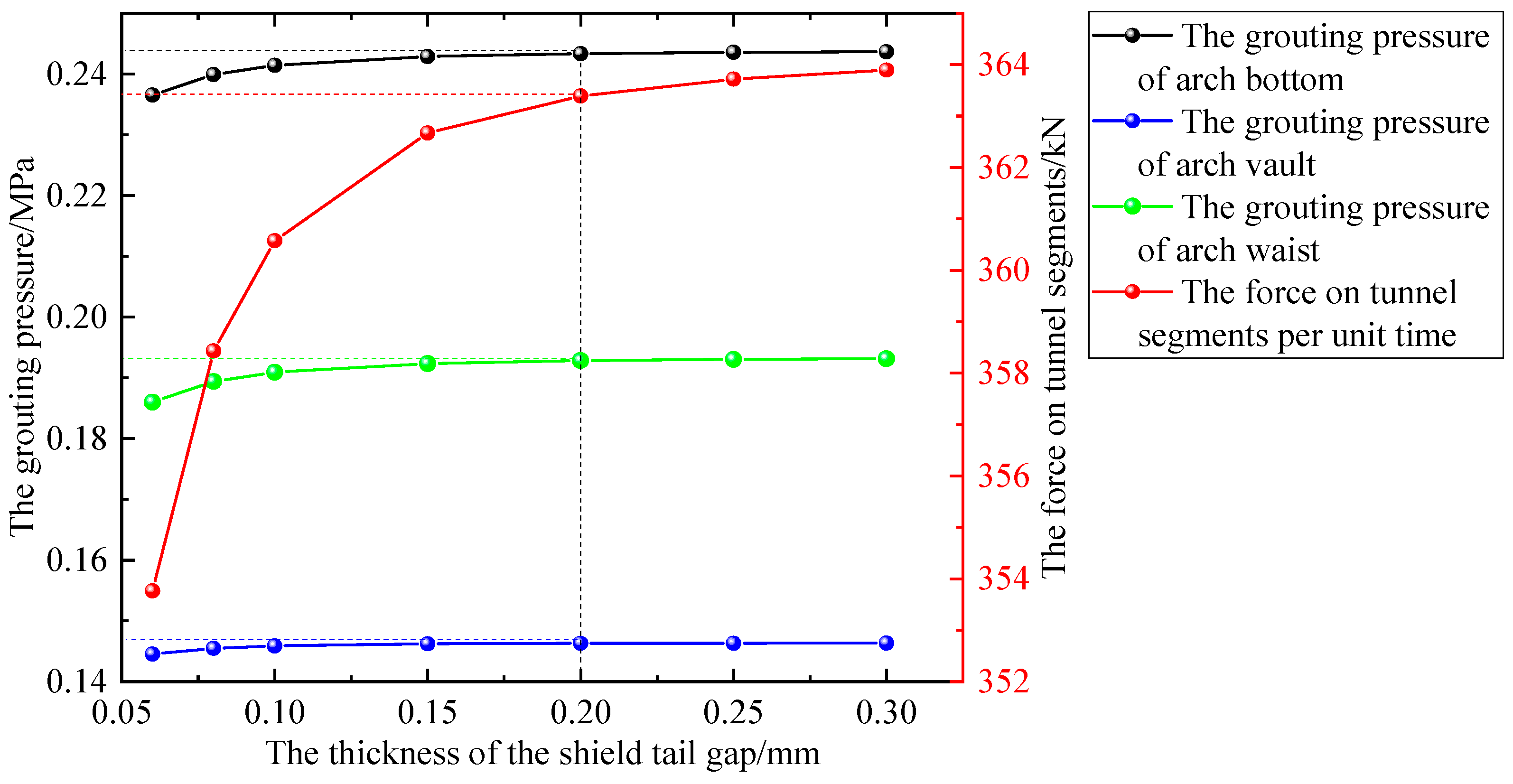
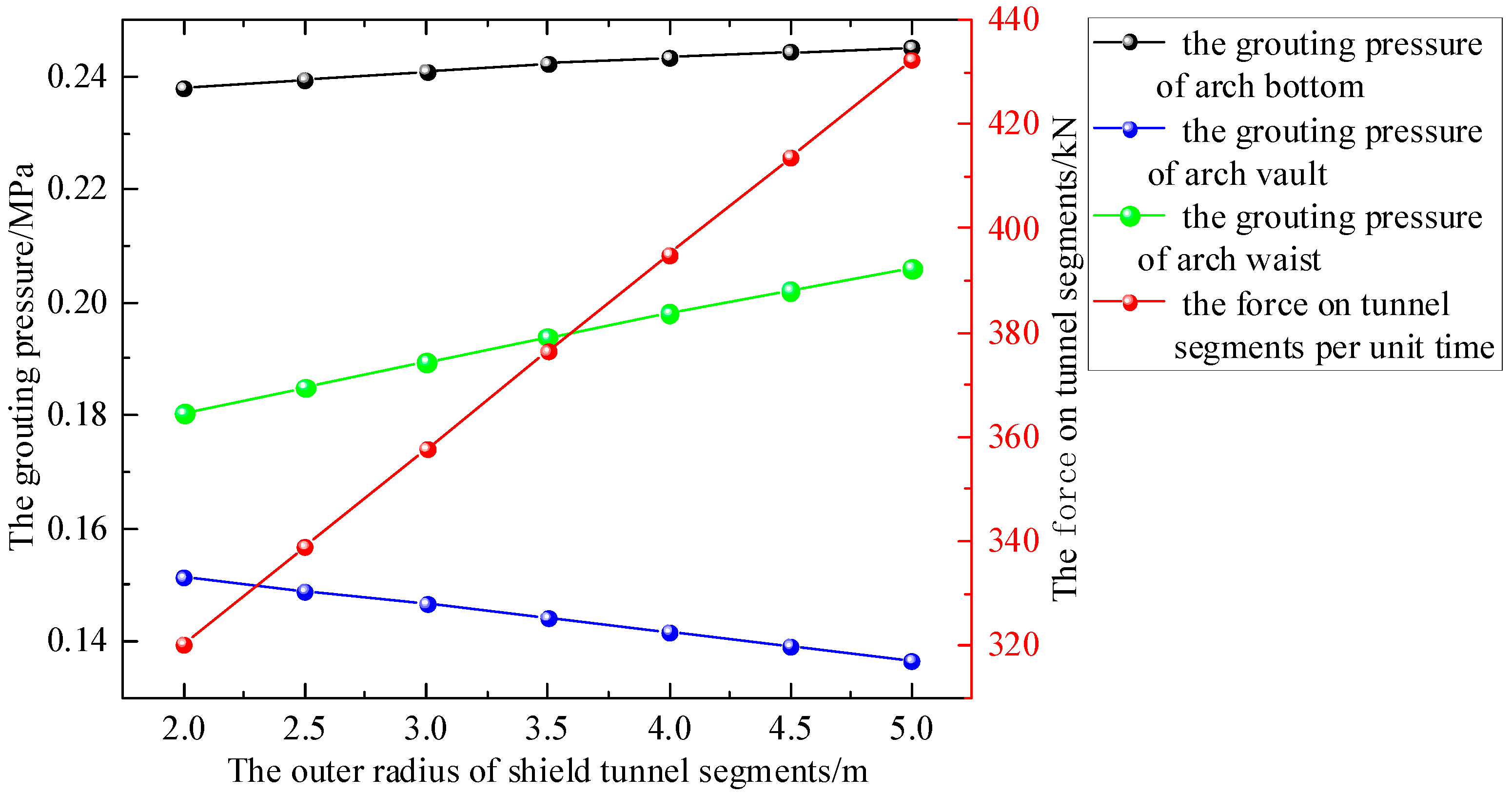
| Parameter | ||||||
| Value | 3100 mm | 100 mm | 20 cm·min−1 | 4 | 0.16 MPa | 0.23 MPa |
| Parameter | ||||||
| Value | 1500 kg/m3 | 0.09 Pa·s | 9 Pa | 1.5 | 1.24 × 10−4 m3/s | 3.71 × 10−4 m3/s |
| Location | Tunnel Vault | Arch Bottom | Left Arch Waist | Right Arch Waist |
|---|---|---|---|---|
| Measured value [19] | 0.148 MPa | 0.265 MPa | 0.206 MPa | 0.189 MPa |
| Theoretical value | 0.146 MPa | 0.242 MPa | 0.191 MPa | 0.191 MPa |
| Parameter | ||||||
| Value | 0.16 MPa | 0.23 MPa | 1500 kg/m3 | 1.5 | 0.09 Pa·s | 9 Pa |
Disclaimer/Publisher’s Note: The statements, opinions and data contained in all publications are solely those of the individual author(s) and contributor(s) and not of MDPI and/or the editor(s). MDPI and/or the editor(s) disclaim responsibility for any injury to people or property resulting from any ideas, methods, instructions or products referred to in the content. |
© 2024 by the authors. Licensee MDPI, Basel, Switzerland. This article is an open access article distributed under the terms and conditions of the Creative Commons Attribution (CC BY) license (https://creativecommons.org/licenses/by/4.0/).
Share and Cite
Cheng, Y.; Liu, X. Research on the Pressure Distribution Law of Synchronous Grouting in Shield Tunnels and the Force on Segments. Buildings 2024, 14, 1099. https://doi.org/10.3390/buildings14041099
Cheng Y, Liu X. Research on the Pressure Distribution Law of Synchronous Grouting in Shield Tunnels and the Force on Segments. Buildings. 2024; 14(4):1099. https://doi.org/10.3390/buildings14041099
Chicago/Turabian StyleCheng, Yang, and Xiangyang Liu. 2024. "Research on the Pressure Distribution Law of Synchronous Grouting in Shield Tunnels and the Force on Segments" Buildings 14, no. 4: 1099. https://doi.org/10.3390/buildings14041099





